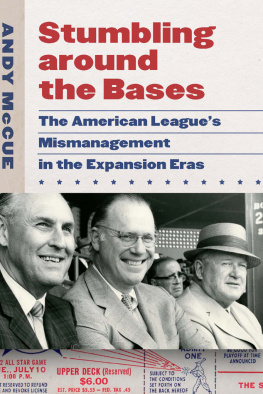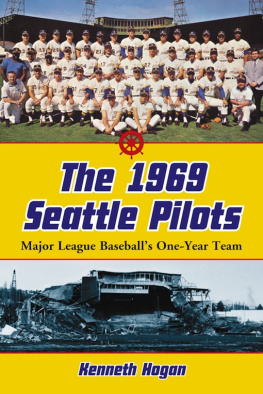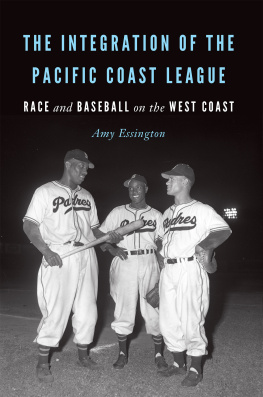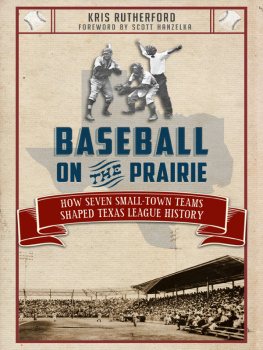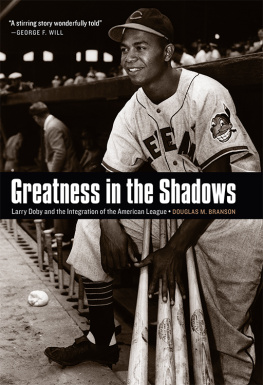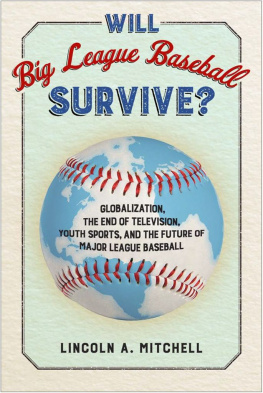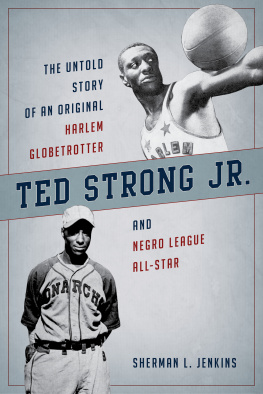Contents



Copyright 2022 by Andy McCue
All rights reserved
Manufactured in the United States of America
Library of Congress Cataloging in Publication Data
Names: McCue, Andy, author.
Title: Stumbling around the bases: the American Leagues
mismanagement in the expansion eras / Andy McCue.
Description: Lincoln: University of Nebraska Press, [2022] |
Includes bibliographical references and index.
Identifiers: LCCN 2021038710
ISBN 9781496207036 (hardback)
ISBN 9781496232182 (epub)
ISBN 9781496232199 (pdf)
Subjects: LCSH: American League of Professional
Baseball ClubsHistory. | Baseball teamsUnited StatesHistory.
Classification: LCC GV875.A15 M338 2022 |
DDC 796.3570973dc23
LC record available at https://lccn.loc.gov/2021038710
The publisher does not have any control over and does not assume any responsibility for author or third-party websites or their content.
The men who run baseball seem to have the memory span of a gnat and the ability to see ahead about 2 inches. This most obvious fact of life, that things change, seems to be totally beyond their ability to plan consciously.
Leonard Koppett, Sporting News columnist,
Sporting News, October 16, 1971
Most baseball owners were what people generally looked on as characters. They were people who had been enormously successful in their work and as a result had a great deal of self-confidence and assurance. Call it ego, if you like.
Lee MacPhail, baseball executive and American League
president, in My 9 Innings
Were all little boys. If we werent, we wouldnt be that interested in sports. Wed be much more interested in what General Motors stock was doing.
Charles Bronfman, Montreal Expos owner,
A New Order Is Emerging, Sports Illustrated, July 17, 1978
Somemaybe mostsports franchises arent especially well managed. Sensible, successful businessmen have been known to change once they become club owners. They do things they wouldnt dream of doing with the businesses that made them successful.
Bill Veeck, owner of three American League teams,
in The All-American Dollar
The owners were a loose amalgam of highly individualistic entrepreneurs. Theyre impatient, egocentric, and exasperating. Most of them had never worked inside structures where cooperation with other strong personalities was required. They were thus very poor at cooperating.
Bruce Johnston, U.S. Steel labor negotiator, in Lords of the Realm
Short was typical of new owners we would see during my tenure, owners who lacked any true affection for baseball but saw the game and the commissioner as devices to further their own business interests.
Bowie Kuhn, commissioner of baseball, in Hardball
The over-riding problem is the intransigence of club owners in dealing with each other. Their inability to agree on a course of action has been dramatized by the present failure to elect a successor to Gen. William Eckert, but the same habit has poisoned baseball health for many years.
Leonard Koppett, Sporting News columnist,
Sporting News, January 18, 1969
Philip Wrigley, who owned the Chicago Cubs from 1932 to 1977, had reached his own conclusion. He always referred to the game as professional baseball rather than organized baseball because it was less organized than anything I have ever been associated with.
Dan Ewald, in John Fetzer
ACKNOWLEDGMENTS
This book began as I researched baseballs 1961 and 1962 expansion while working on my biography of the Dodgers Walter OMalley. Analysis did not favor the American League. I began to look at other decisions the leagues owners made both before and after that expansion. The search soon revealed a pattern of reactive, poorly analyzed moves over several decades and I turned to friends, colleagues, and librarians to help me understand.
My initial thinking was greatly advanced by long and very helpful conversations with Mark Armour, Dan Levitt, and Anthony Giacalone.
As I dove into the research, I was helped by colleagues in the Society for American Baseball Research (SABR)Ron Antonucci, David Bohmer, John Heer, Jeff Katz, Ron Selter, Andy Sharp, Steve Treder, Steve Weingarden, John Zinn, and Tom Zocco. Mike Haupert, Brian Borawski, Steve Weingarden and the members of SABRs Business of Baseball Committee and their research on baseballs winter meetings provided a consistent reference point. Mike Fuller and his excellent Seattlepilots.com website provided material not available elsewhere.
Libraries and archives were indispensable, beginning with Jim Gates, Matt Rothenberg, and Cassidy Lents at the Baseball Hall of Fame. Also, staff at the Chicago Historical Society, Chicago Public Library, the Dallas History and Archives section of the Dallas Public Library, the Sports Research Center at Cleveland Public Library, the newspaper archive room at the New York Public Library, the Burton Historical Collection at the Detroit Public Library, the Frank P. Zeidler Humanities Room at the Milwaukee Public Library, and the public library systems in Baltimore and Los Angeles. A large thank you to Susan Goldstein and the staff at the San Francisco History Center, San Francisco Public Library. And, as always, Wayne Wilson and the staff at LA84.
In academic circles, Joanne Oxley of the University of Toronto and Margaret Levenstein of the University of Michigan provided helpful context.
Baseball industry figuresPeter Bavasi, Roland Hemond, Bob Lurie, and Ross Newhantook time to talk to me.
A special thank you to my colleagues in BASE (Baseball Authors and Speakers Exchange [https://www.baseballauthors.com])Rob Garratt, Steve Gietschier, Dan Levitt, Rob Fitts, Rick Huhn, Jean Ardell, Dennis Snelling (who also helped with background on the Soriano brothers), and the indefatigable Bill Lambwho read all or part of my early drafts and produced twenty-four single-spaced pages of much-needed critique. Rob Garratt and Steve Gietschier were particularly helpful at identifying organizational problems, which I hope I rectified. I would also like to acknowledge my friend of almost half a century, Marty Beiser, for using his exceptional editing skills on the manuscript.
Appreciation to my son Michael Ageno and the talented and beautiful Mary Colleen Kenney for their ideas on the dust jacket art.
At the University of Nebraska Press, my thanks to Rob Taylor, Courtney Ochsner, and Rosemary Sekora. I thank Jessica Ryan for the copyediting.
A large drop of gratitude to the Sporting News for its decades of coverage of the great game both on and off the fieldand a tear for its demise. A bow to Leonard Koppett for his stories and columns in the Sporting News and the New York Times, which set a standard for serious sports journalism. A grateful acknowledgment of Retrosheet.org and baseball-reference.com for their invaluable databases of just about everything that happened on the field.
And, above all, my thanks and gratitude to the talented, kind, and beautiful Mary Colleen Kenney for fifty-four years of companionship and forty-four years of toleration.
INTRODUCTION
September 21, 1971, was a mild, humid day with light rain in Boston. Inside the Sheraton-Plaza Hotel, where the dozen men who ruled baseballs American League were grappling with yet another self-made disaster, the air was cooler and dryer. But in their meeting room, the heated discussions endured for thirteen and a half hours. What should they do about their franchise in the nations capital?

